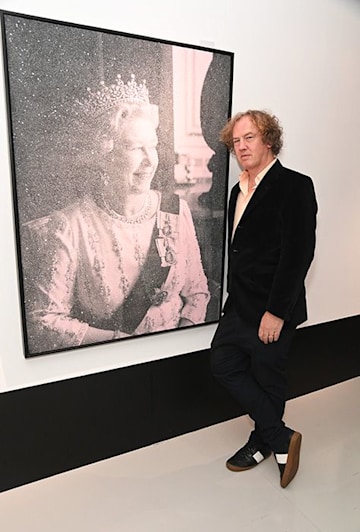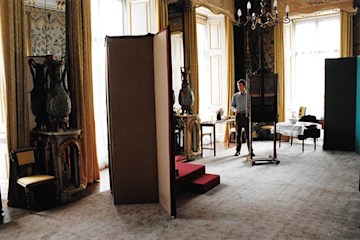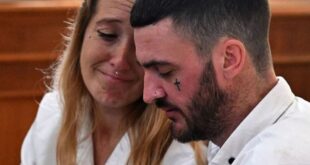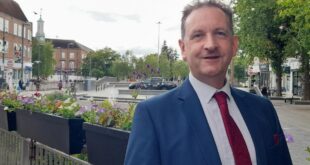Sophie Hamilton
Queen Elizabeth II’s portrait artists exclusively speak to HELLO! about their time spent with the late monarch as their works appear in a new exhibition, Majesty: A Tribute to the Queen
The nation is still mourning the loss of our beloved Queen Elizabeth II with many of us thinking back to our fondest memories of the late monarch who reigned for an amazing 70 years.
MORE: The special way the Queen’s memory will be honoured – and it’s so touching
Now, three artists who portrayed the Queen throughout her life and spent time with her while she sat for their portraits, are showing their work in an exhibition titled Majesty: A Tribute to the Queen. The exhibition at London’s Quantus gallery runs until 12 October.
WATCH: Royal mail unveil new Queen Elizabeth II stamps
The three artists, Christian Furr, Rob Munday and Frances Segelman, captured Her Majesty via the mediums of photography, holography, painting and sculpture.
HELLO! paid a visit to the exhibition, and we have to say, the works are simply breathtaking – shown together in one space, the Queen felt almost present in the room. It’s a wonderful tribute to an incredible monarch.
Read our exclusive interviews with the artists below as they recall fascinating personal stories of Her Majesty behind closed doors…
MORE: How and when you can visit the Queen’s final resting place
Artist Christian Furr
British artist Christian Furr was the youngest artist ever to be commissioned to paint an official portrait of the Queen when he was 28.
Personally selected for the honour, his painting aimed to show both the regal and human qualities of the monarch. The portrait currently hangs in the Royal Overseas League.
Christian knows the Queen liked his portrait of her, as in In 2010, Prince Philip met him personally to accept a special print of the painting. In the Majesty: A Tribute to the Queen exhibition, he dedicates a new ‘diamond dust on canvas’ edition portrait of the Queen based on his unreleased photograph of her smiling.

The artist Christian Furr Photo credit: Dave Benett | Getty
Christian tells HELLO! of his first meeting with the Queen: “I didn’t know what to expect. I was 28. I knew that this was the Queen of England, I didn’t have any preconceptions.
“As soon as she walked in, the nerves dissipated, they just evaporated because she was very good at putting people at ease and she had a great sense of humour.”
He recalls: “I remember talking about paintings. She said, ‘What artists do you like?’ and I said, ‘I really like Gainsborough and Reynolds’. She said, ‘I think we’ve got a few of those downstairs.’
“She was talking about memories of meeting people on walkabouts. She had a brilliant memory; she was very sharp, very savvy and knew what was going on and had a great interest in current events.”
Before painting the Queen, Christian met with the monarch’s personal dresser Angela Kelly to choose her outfit for the portrait.
“I chose the Order of the Star and Garter because that was what she was wearing on billboards. It was red, white and blue. I wanted those colours in the portrait but I wanted to go a bit closer than previous portraits that had been done, to capture that element of her character, which is the liveliness and the humour – she had a delicious sense of humour.”

Christian painting the Queen at Buckingham Palace
“I chose the platform that she was going to be raised upon, the red velvet background and the flowers – I wanted flowers as it brings the outside in. The Queen chose the tiara of the Girls of Great Britain and Northern Ireland, which I think Queen Mary had given to her as a present.
“She also brought, when she came into the yellow drawing room, a shawl or a blanket. She said straight away, ‘Oh, do you mind if I put this on the chair?’ I said, ‘No’. I knew straight away that that would reveal something about her character – that was a chance element.”
Christian explains that his new diamond dust portrait of the Queen came about from a funny moment.
“The diamond dust edition is an image that’s a very happy memory for me, because I said something that made her laugh. It was something probably a bit… something I shouldn’t have said! But that’s what a portrait sitting is – it’s a bit of a time out. It’s not recorded, it’s intimate time.”
MORE: Queen Elizabeth II, five, is the most regal bridesmaid in unearthed royal wedding photos

Christian Furr gives Prince Philip a print of the portrait
The artist tells us about another story from his time with the Queen, recalling: “I was talking about some of the previous depictions that had been done of her – and bear in mind I was 28 and a bit naïve. There’s an Annigoni portrait where she’s looking very majestic. It’s lovely, but I said to her at the time, ‘If you don’t mind me saying, you look a little bit haughty in that picture.’
“I’m thinking about it now and thinking what the hell did I say that for?! She didn’t blink, and she went, ‘Well there’s a reason for that.’
“She said, ‘Just as you’re asking me to look out the window now, Annigoni did the same thing but in this case, I was on the ground floor and there’s a really high wall outside and I ended up straining to see what was over the wall. That’s why I look like that in that painting.'”
Christian also remembers looking out of the window from Buckingham Palace at the crowds in the streets below. He tells us: “She said something like, ‘I don’t think people realise that we live here!”
“The other funny thing that happened,” he continues, “Is during the sittings at the end (it was the days of film before digital cameras), I said to the Queen, ‘I’ve got all these things, I’ve got to get them developed, what should I do?’
“The Queen said, ‘There’s a chemist over the road, that’s where we go.’ I thought that was funny. It was ordinariness that dissipated any nerves.”
“My lasting memory of her is being very low key. She didn’t like fuss. She sort of craved ordinariness but she was majestic, so she was a bit of a paradox in that sense. I hope in my portrait I captured that. It was carte blanche; I could depict her in any way. I wanted to depict her as an icon but also capture her humanity.”
Sculptor Frances Segelman
Royal sculptor Frances Seleglman captured the Queen’s symbolism and personal warmth in her 2009 sculpture of the late monarch.
Frances sculpted several versions of the Queen. The version that resides at Buckingham Palace is without a crown, as the Queen requested it in keeping with the informal dress worn by her husband Prince Philip in the sculpture Frances had already made of him. The two sculptures are displayed together at the Palace.
Frances’ other sculptures of the Queen have crowns on them, including the one displayed in the ‘Majesty’ exhibition. Frances has also sculpted works of King Charles III, the Princess Royal, the Duke of Kent and the Countess of Wessex.

Royal sculptor Frances Seleglman Photo credit: Dave Benett | Getty
Frances tells HELLO! of her time with the Queen: “I had three sittings. It was so wonderful and so many different things happened in those sittings and through those years I was doing it.
“I just remember this wonderful slight lady walking into the room and how very normal in so many ways she was, but how in my sculpture I feel I’ve got the power that she had. In a very quiet way, she was a very powerful person, but she came across as a very normal person.”
I ask what their conversations were like during those three sittings…
“So many conversations really, she was talking so much, all the time,” says Frances. “There were lots of things that I wouldn’t discuss, but there was lots of caring and talking about the people walking around in front of the palace. She was always so worried about that, worried about anybody getting run over because she said they don’t look properly where they’re going – at that time it was a road.
“She was talking to me about people staying at the palace, coming from different countries staying there and how they were in the palace and what they were like, and how they would act in the palace – things like that.
“Then she was talking about how she was going on a trip up north the next day and about Princess Anne… we heard a helicopter and it was Princess Anne landing in the garden!”

Frances working on her sculpture of the Queen
Frances recalls the room she would work on her sculpture in at the palace: “I was in the room that’s set aside for artists [the balcony room at Buckingham Palace]. I don’t know if it’s still that room, but it was a corner room, so you had the light from both sides. It was amazing, oriental, beautiful, magnificent.
“I used to get there early, have a cup of tea and calm myself down a bit. It was quite incredible when you look out from that room and see the crowds, and you realise, to live like that must be quite hard really – to live there with all the people outside.
“She lived far back in the palace at that time. The Duke of Edinburgh used to say when he came to my sittings, ‘Oh I had quite a long walk to get here’. I think they were in a flat somewhere at the back at that time.”

Frances with her sculptures of the Queen and Prince Philip Photo credit: Dave Benett | Getty
What did the Queen think of Frances’ finished work?
“I think the Queen really liked the sculpture. The last sitting, I asked her if she liked her hair and the length it was. She asked me if I could make it a little bit shorter, so I did, and she was happy with it. I said, ‘Are you happy for this to go to the studio now with me? She said, ‘Yes, and don’t fiddle with it!’
“I knew that this very much meant that she liked it, there was no doubt about that. And also, at the unveiling – she loved it because she saw all the glitter on it and she thought that was amazing.”

The Queen with Frances’ sculpture
Frances tells us that the Queen was always punctual for her sittings with her – we’d expect nothing less from the monarch so focussed on duty.
What is Frances’ lasting memory of Her Majesty? “My lasting memory is never realising that she would die – you thought she would go on forever, she was so strong and powerful. I adored her.”
Holographer Rob Munday
We absolutely love that the late Queen agreed to have a holographic portrait done of herself during her reign – it shows that while she was a monarch of tradition and duty, she also had a fun side and enjoyed modern art.
Holographer Rob Munday is best-known for creating the first officially commissioned 3D/holographic portrait of Her Majesty in 2004. His and artist Chris Levine’s portrait, Equanimity, has since become one of the most iconic images taken of the Queen and now hangs in the National Portrait Gallery. Munday also unveiled his work, Felicity: Platinum Queen, for the Queen’s Platinum Jubilee.
When HELLO! visited the ‘Majesty’ exhibition, it was fascinating to see Rob’s holographic portrait of the Queen up close. As you walk by it, the image appears 3D and the Queen’s eyes seem to follow you – truly remarkable.

Holographer Rob Munday Photo credit: Dave Benett | Getty
The artist has also produced the world’s first gold holographic portrait miniature, which is shown at the exhibition, along with his new portrait In the Blink of An Eye, a tribute to his special personal memories and artistic relationship with the Queen.
Rob tells us of the Queen’s first holographic photo ‘Equanimity’: “It was an equal creative collaboration between myself and the artist Chris Levine and commissioned by the Jersey Heritage Trust.
“They had seen three of my previous holographic portraits of Seal and Noel and Liam Gallagher, which I shot in my studio in Richmond. On the basis of seeing those holographic portraits, they commissioned a holographic picture of the Queen, which was incredibly brave because it was such new technology – even now it’s new technology.”

Felicity: Platinum Queen
Was the Queen how he expected her to be on his first meeting?
Rob reveals: “I had no idea; I don’t think anybody did really know what the Queen would be like. All three of us [Rob, Christian and Frances] have said that she was completely disarming, completely normal. It was this little, very, very friendly, kind lady. She was in her late 70s when I did my portrait, but she was lovely and very accommodating.
“Everybody was really nervous to start with and I was particularly nervous because I’d spent three days there building the whole studio and praying that it worked, so it was a long lead-up to that moment. Three o’clock in the afternoon and the door opened and in walked the Queen.”
He continues: “The ice was broken by a comment that was made by one of the assistants – that it was a bit like having your passport photograph done, and she quick as a flash turned around and said, ‘Oh I don’t need a passport’.
“After that, you felt you could speak, because at the beginning you’re not sure if you can say something or not, or what to say, and everybody was a bit like rabbits in the headlights. But then very quickly after five or ten minutes, the conversation flowed.”

Rob Munday and Chris Levine’s Equanimity
We ask what was the Queen like during their time together and how she reacted to seeing her first holographic portrait.
Rob explains: “She had a lot of portraits made and my impression was that she was very compliant – although I only spent three hours with her. Two sittings, an hour and a half each sitting, but there was never any sense that she didn’t want to be there or have her portrait made.
“In between the two sittings, I made the first-ever hologram [of the Queen] which I still have, and I showed it to her at the second sitting, and she was very complimentary. She said, ‘Oh that’s lovely, it’s very interesting’ and she was tilting it to see the three-dimensional effect’.
“It was latterly used for the world’s first £100 banknote in Jersey and for the world’s first holographic stamps, which I did myself as well in 2011.”
Rob tells us that his intention was always to do a starkly realistic portrait of the queen – the medium doesn’t allow for image processing and the removal of wrinkles. “She seemingly was very comfortable with that,” he recalls.
Of course, like all of us, Rob was deeply saddened to hear of the monarch’s passing, telling us that when he heard the news he was out of the country.
“I was actually at my home in the Pyrenees mountains in France, and of course, one had been worried before when she had Covid, but of course, it comes as a shock. As everybody says, she’s been with us all her life. I first photographed her in 1977 when I was 19 years old on her visit to Norwich on her Silver Jubilee – and the photo was completely blurred!”
Where will his portraits of the Queen be kept now, we wonder?
“The main commissioned work Equanimity lives in Jersey in Mont Orgueil castle and the one at the exhibition is the artist’s proof of the final commissioned work. As for my works, well we’ll see…”
Majesty A Tribute to the Queen runs from 28th September- 12th October at Quantus Gallery London quantusgallery.com
Make sure you never miss a ROYAL story! Sign up to The Royal Explainer newsletter to receive your weekly dose of royal features and other exclusive content straight to your inbox.



